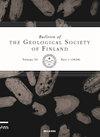爱沙尼亚西部Osmussaar岛近岸水动力与沉积物运动关系分析
IF 1.3
4区 地球科学
Q2 GEOLOGY
引用次数: 10
摘要
在野外考察、水文气象资料和海浪预报的基础上,对Osmussaar石灰岩荒岛的海岸发展及其水动力强迫条件进行了研究。Osmussaar岛的面积增长在2000-3000年前从波罗的海出现,此后一直在增长,由于当前全球海平面上升几乎抵消了局部均衡的冰川后隆起,它的面积增长几乎停止了;然而,由于来自西北暴露的Osmussaar悬崖和它前面的海底石灰岩长凳的海浪侵蚀的物质逐渐堆积,它在岛的南岸继续存在。根据对古地图、摄影材料和Osmussaar海岸研究地点的平整调查的分析,整个岛屿正在缓慢地向东南迁移。与20世纪60年代和70年代相比,沿海变化的速度从每海岸线米0.2 m2 y-1增加到1.2 m2 y-1。2011年进行的一项涂漆沉积物实验揭示了海滩山脊的近岸觅食区。在向风、向西暴露的海岸,暴风雨和高海平面事件有所增加。波浪气候经历了一些周期性的变化,上一个高峰期在20世纪90年代,新的周期可能在2010年再次开始。本文章由计算机程序翻译,如有差异,请以英文原文为准。
Analysis of relationships between near-shore hydrodynamics and sediment movement on Osmussaar Island, western Estonia
Based on field studies, hydro-meteorological data and wave hindcasts, coastal developments and their hydrodynamic forcing conditions are studied on the limestone relict island of Osmussaar. Areal growth of Osmussaar Island, which emerged from the Baltic Sea 2000–3000 years ago and has grown ever since, has practically stopped as the current global sea level rise nearly balances out the local isostatic post-glacial uplift; yet it continues on the southern shores of the island as a result of gradual accumulation of the matter eroded by waves from the north-westerly exposed Osmussaar cliff and the submarine limestone bench in front of it. Based on analysis of old maps, photographical material, and levelling surveys from coastal study sites on Osmussaar, the island as a whole is slowly migrating to the south-east. Compared to the 1960s and 1970s, the rate of coastal changes has increased from 0.2 m2 y-1 to 1.2 m2 y-1 per shoreline meter. A painted sediment experiment conducted in 2011 revealed the nearshore feeding zones for beach ridges. Storminess and high sea level events have increased on the windward, westerly exposed coast. Wave climate has undergone some cyclical changes with the last high phase in the 1990s and a new cycle probably started again 2010.
求助全文
通过发布文献求助,成功后即可免费获取论文全文。
去求助
来源期刊
CiteScore
1.30
自引率
0.00%
发文量
5
审稿时长
>12 weeks
期刊介绍:
Bulletin of the Geological Society of Finland (BGSF) publishes research articles and short communications in all branches of geosciences. Contributions from outside Finland are welcome, provided that they contain material relevant to Finnish geology or are of general interest.

 求助内容:
求助内容: 应助结果提醒方式:
应助结果提醒方式:


